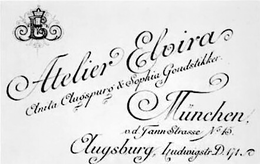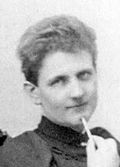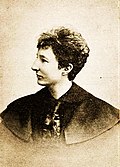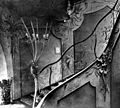Atelier Elvira

The Atelier Elvira , also court workshop Elvira or Salon Elvira called, was in 1887 by Anita Augspurg and Sophia Goudstikker as a photo studio in Munich founded. It gained fame through the work of the founders in the women's movement . A branch had existed in Augsburg since 1891 . The new building of the Munich studio, built in 1898 at Von-der-Tann-Straße 15, was an important Art Nouveau building .
history
Headquarters in Munich
Anita Augspurg and Sophia Goudstikker, who lived as a couple, moved from Dresden to the more liberal Munich in 1886 . Both trained as photographers and opened the Munich studio on July 13, 1887 at Von-der-Tann-Strasse 15, diagonally across from the Prinz-Carl-Palais . One of her focal points was portraits of children, which were considered difficult because of the long exposure times at the time. Many women - including well-known writers and women's rights activists - had Goudstikker portray them. The studio was not only well received by wealthy citizens, but also by aristocratic circles and senior court and state officials. With Goudstikker's appointment as a royal Bavarian court photographer , the Elvira was also allowed to use the name court studio .
In 1897 the operators decided to build a new building, and August Endell received the order . In a letter from November 1897 he wrote: I will probably be building next spring. Only small, but everything, the entire interior decoration, doors, window friezes, capitals, cornices, painted ornaments, banisters, grilles, wrought-iron doors ... The approval was in April 1898, not without the caustic remark of an official, the drafts of the self-taught Endell would be a "mockery of the art of drawing". In the summer of 1898, construction work began on the studio and on a residential building separated by a garden (Königinstraße 3a). The windows of the facade had indented upper corners and wavy bars. The forged grille of the entrance door was given the shape of a thorn tree. The sculptor Josef Hartwig took over the work on the "dragon ornament" . It took four weeks to apply the mortar, the external dimensions were 13 × 7 meters. The wall was painted sea green, the ornaments pink-violet and turquoise. The ceiling of the reception room was dominated by a three-dimensional, rootstock-like structure, behind which the room opened with a round arch to a 180-degree spiral staircase with a curved railing and a floor lamp with floral shapes. The stairs received light through a sloping glass roof. Endell dispensed with ornaments in the house that was being built at the same time. The shapes were deliberately ambiguous and should allow the most diverse associations. For example, what Ulrich Simon stated for the Art Nouveau in general, namely that he primarily advertises himself, may apply to the Elvira Atelier . Endell avoided any proximity to the naturalism that he perceived as outmoded . The facade in particular encouraged biting comments: The house was built in the “polyp rococo”, a “dragon castle” or “Chinese embassy”.
The two founders separated soon after the house was completed, and Goudstikker continued to run the business alone. In 1907 Augspurg sold her share to Goudstikker, who leased the studio to the 28-year-old photographer Emma Uibeleisen in 1908 so that she could devote herself more to her work for the women's movement. After the First World War that followed , however, the old customers were largely absent, and when Uibeleisen died in 1928 there was no successor. In the autumn of 1933, an SA unit was quartered in the house , later, in the course of the redesign of Von-der-Tann-Strasse as the main entrance to the House of German Art, a temporary canteen. In 1937 the "dragon ornament" was knocked off and whitewashed; the house itself was to give way to an arcade, which was discarded during the Second World War . It was badly damaged during a bombing raid in April 1944. The Free State of Bavaria acquired the property after the war and left it to the USA for the construction of their Consulate General building .
View of the Prinz-Carl-Palais and the Consulate General of the USA
Augsburg branch
Augspurg and Goudstikker set up a branch atelier in Augsburg in the back yard of the Litera D 171 building (Ludwigstrasse 22) in 1891. It existed under the same name but with different operators until 1944. On February 26, 1944, it was destroyed by bombs.
Work (selection)
Anita Augspurg , Marie Stritt , Lily von Gizycki , Minna Cauer and Sophia Goudstikker (from left to right), around 1894
Suffragette Helene Lange , before 1899
Writer and historian Ricarda Huch , 1901
The writers Heinrich and Thomas Mann ,
around 1902Regent of the Grand Duchy of Luxembourg Maria Anna of Portugal , 1903
Grand Duchess of Russia Victoria Melita of Saxe-Coburg and Gotha
King Ludwig III. of Bavaria , 1914
literature
- Nikolaus Schaffer: Architecture as a picture . The Elvira Atelier - a unique piece in architectural history. In: Rudolf Herz, Brigitte Bruns (ed.): HOF-ATELIER ELVIRA 1887–1928 . Aesthetes, emanciers, aristocrats. Exhibition catalog Fotomuseum in the Münchner Stadtmuseum 1985, pp. 5–24.
- Nikolaus Schaffer: Architecture as a picture: the "Atelier Elvira" by August Endell. Dissertation University of Salzburg 1981.
- Rudolf Herz, Brigitte Bruns (ed.): HOF-ATELIER ELVIRA 1887–1928 . Aesthetes, emanciers, aristocrats. Exhibition catalog Fotomuseum in the Munich City Museum 1985.
- August Endell: the architect of the Elvira photo studio. 1871–1925 , exhibition catalog Stuck-Jugendstil-Verein, Munich, 1977.
Individual evidence
- ↑ The previous building of Atelier Elvira with the owners Anita Augspurg and Sophia Goudstikker was also in vd Tannstr. 15 reported, see: [1] , p. 134, col. 3; Anita Augspurg for herself, however, in Veterinärstr. 5, garden house: Augspurg Anita photographic institute (special photos of children) Veterinärstr. 5 . See: [2] , p. 11, column 3, accessed on November 15, 2015.
- ↑ a b Ludwigstrasse 22 "Elvira Photographic Atelier" . In: Franz Haußler: Photography in Augsburg 1839–1900. Wißner Verlag, Augsburg 2004, ISBN 3-89639-432-0 , pp. 154f. Digitized
- ^ Süddeutsche Photographen-Zeitung , Volume I (April 1894 - March 1895), J. Lindauer, Munich, p. 30; According to this announcement, both Sophia Goudstikker and Anita Augspurg were appointed court photographers by Ludwig von Bayern.
- ↑ Hans-Ulrich Simon: Secessionism, applied arts in literary and visual arts . Stuttgart 1976, p. 182. Quoted from: Nikolaus Schaffer: Architektur als Bild . The Elvira Atelier - a unique piece in architectural history. In: Rudolf Herz, Brigitte Bruns (ed.): HOF-ATELIER ELVIRA 1887–1928 . Aesthetes, emanciers, aristocrats. Exhibition catalog Fotomuseum in the Münchner Stadtmuseum 1985, p. 23.
- ^ A b Edgard Haider: Lost splendor - stories of destroyed buildings. Chapter: The "Drachenburg" of two women's rights activists. Hofatelier Elvira, Munich. Gerstenberg Verlag, Hildesheim 2006, ISBN 3-8067-2949-2 , pp. 142ff.
- ↑ Herz / Bruns, Elvira court studio. P. 112.
Web links
- Fotoatelier Elvira: The first abstract work in art history (LWL-Presse-Info from October 19, 2007) accessed on August 12, 2012













